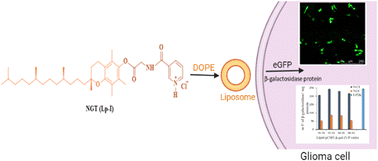Nicotinic acid-based cationic vectors for efficient gene delivery to glioblastoma cells†
Abstract
The production of efficient vectors is an essential aspect of gene therapy, which is a revolutionary method for delivering therapeutic nucleic acids. Targeted gene therapy to deliver the nucleic acids to various human cells is a current challenging task. Brain-targeted gene delivery using novel synthesized cationic lipids is one of the developing approaches. To establish targeted gene delivery to brain cancer cells, two nicotinic acid-based cationic lipids with varying hydrophobic regions, one with alpha-tocopherol (NGT) and the other with a long hydrocarbon chain (NGC), were developed and synthesized in this study. For the production of sustained aqueous forms of synthesized cationic lipids, they were formulated with DOPE (1,2-dioleoyl-sn-glycero-phosphoethanolamine) as a co-lipid. The physicochemical properties of these formulations, such as their hydrodynamic size and zeta potential, were examined and found to show optimum results favourable for testing for transfection. DNA binding and heparin displacement assays clearly illustrated the interaction of the liposomes with plasmid DNA. The cytotoxicity of the liposomes and lipoplexes was examined and found to be minimal in multiple cell lines. Further, their transfection potentials were investigated, and U87 and GL261 cells showed superior transfection with the lipid NGT. In particular, cytoplasmic fluorescence cellular uptake assays with the two cationic lipid formulations showed effective uptake in U87 cells for the lipid NGT. The serum compatibility of the lipids NGT and NGC was analysed through β-galactosidase protein activity for serum concentrations of up to 50%. The synthesized nicotinic acid-based cationic lipids specific binding interaction to α7 nicotinic acetylcholine receptor (α7nAChR), which is expressed in astrocytes in the brain, was explored using a molecular docking study, and the lipid NGT showed higher docking. In identifying these receptors, the nicotinic acid-conjugated tocopherol amphiphile was shown to be effective, indicating a possible lipid-based method for targeting brain cancer cells.



 Please wait while we load your content...
Please wait while we load your content...